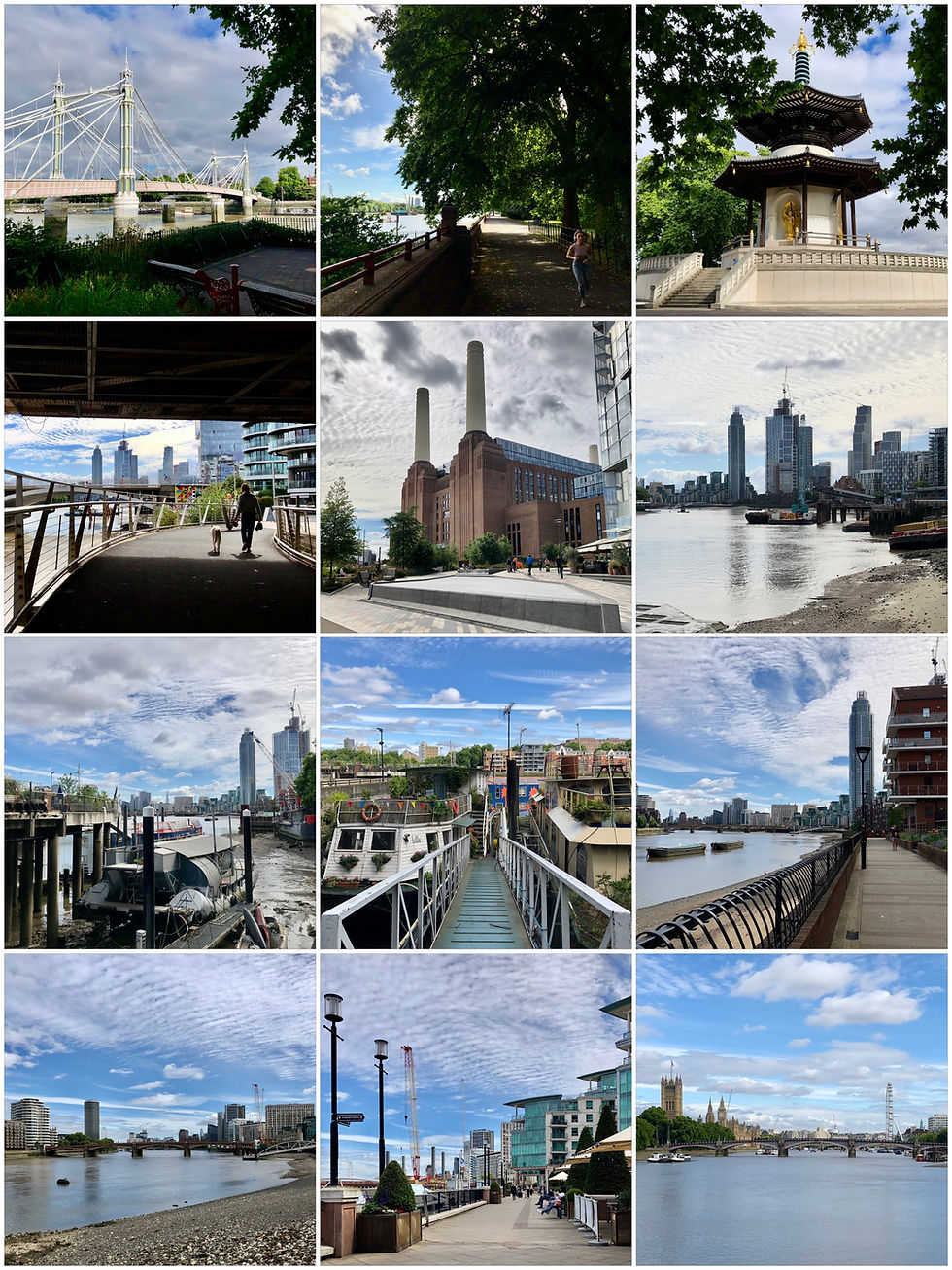Albert Bridge - Vauxhall Bridge - Waterloo Bridge - Tower Bridge: 6 miles (10 km)
Whilst only 6 miles in length, this section of the south bank path includes many sites and buildings that characterise London’s great history, past and present, many being naturally regarded as some of London’s principle landmarks. Departing from my usual format, I’ll keep the narrative on this occasion to a minimum and let the pictures do the talking!
Rejoining at Albert Bridge (1873) and on to the Promenade edging Battersea Park, the inviting long stretch ahead offers fine views both into the Park including Peace Pagoda and Zoo and across the Thames until finally arriving at Chelsea Bridge, which is now possible to pass under and enter waterside into the magnificent, newly redeveloped Battersea Power Station complex. Stunning views downstream towards Vauxhall Bridge open up as the new riverside path weaves back and forth slipping passed historic houseboats and jetties until eventually arriving at the impressively stepped George Wharf development overlooked by the sleek and graceful St. George Wharf Tower. Crossing Vauxhall Bridge the Thames Path leads passed the Terry Farrell MI6 building and onto the Albert Embankment, whereupon Lambeth Bridge and the Palace of Westminster come into view on the north bank and the London Eye, on the south.

The Albert Embankment offers perfect views of Westminster and the Houses of Parliament as they approach and a sense of the bustle that awaits on the South Bank further ahead. Crossing Lambeth Bridge (1932), a peace descends as this upcoming section is the home of the National Covid Memorial Wall, decorated with over 150 000 love hearts in memory of lost lives during the pandemic. The cast-iron sturgeon lampstandards that adorn much of this embankment act as dutiful sentries to this memorial. Immediately to the right are the grounds of resplendent Lambeth Palace (1435) and as Westminster Bridge approaches, the formidable complex of St Thomas’ Hospital which immediately opposite stands Big Ben, now magnificently restored. Over Westminster Bridge (1862), the Thames Path leads on passed County Hall (1922), the London Eye and the reimagined airy Jubilee Gardens. Continuing on and passing under The Jubilee Footbridges and Hungerford Railway Bridge, London’s Festival Hall built in 1951 to celebrate the Festival of Britain takes centre stage on this South Bank. Extremely busy with visitors and Londoners alike, many restaurants, cafes, food trucks, buskers and street performers bring considerable life and atmosphere to this cultural part of Central London. Passing the skateboarding park, Festival Pier, Queen Elizabeth Hall and Hayward Gallery, the secondhand book and record open air market await underneath the graceful span of Waterloo Bridge (1944).

Immediately to the right now is the National Theatre (1976) followed by the IBM building and then shortly followed by esoteric Gabriel’s Wharf, now with its many cafes and craft shops. Further on, the Art Deco OXO Tower with undercover eateries and art shops stands prominently at the waterside followed by Sea Containers House.
Lying ahead is colourful Blackfriars Bridge (1869) it’s architectural ornamentation echoing the former Blackfriars Church. Taking the underpass, the walls of which are adorned with delightful designs of the Bridge since inception and exiting, the columns of the old Railway Bridge which still stand, appear alongside the more robust replacement Railway Bridge (1886). A broad concourse opens up now with The Tate Modern, once the Bankside Power Station, a leviathan of a building taking centre stage. Immediately opposite is the Millenium Bridge (2000) and an uninterrupted view of St Paul’s Cathedral and then shortly after, Shakespear’s Globe theatre (1997): an astonishing replica of the former theatre of the same name. Passing underneath both Southwark Bridge and soon after Cannon Street Railway Bridge, flanked with eye-catching original brick towers, through Vinopolis, passed the Clink Prison Museum, the paved path now leads past a remnant of Medieval London; the Rose window and wall of Winchester Palace. A little ahead a small dock is occupied by a full size replica of Francis Drakes’ Golden Hind and beyond following cobbled lanes, the bustling Borough Market located adjacent to the now restored gothic styled Southwark Cathedral (circa 13th C). The Shard stands tall, an unmistakable landmark on London’s skyline as the path crosses London Bridge and descends onto The Queens Walk. London Bridge Pier and immediately beyond Hay’s Galleria shopping mall, presently hosting the ‘Chimps are family’ sculpture exhibition with 28 tactile bronze sculptures, face thriving Fenchurch Street and the City of London on the opposite Bank. Docked via an adjoining pier lies HMS Belfast and as backdrop, sits London’s Tower Bridge (1886) eminently dominating the view eastwards. Opposite now stands TheTower of London, but as this section (2) draws to a close, the egg shaped City Hall sits pride of place on the waterfront amidst a glorious plaza of modern office blocks known as More London Riverside. A spectacular finish to this days walking with both the river and waterfront alive and thrumming with newcomers and residents alike.

Comments